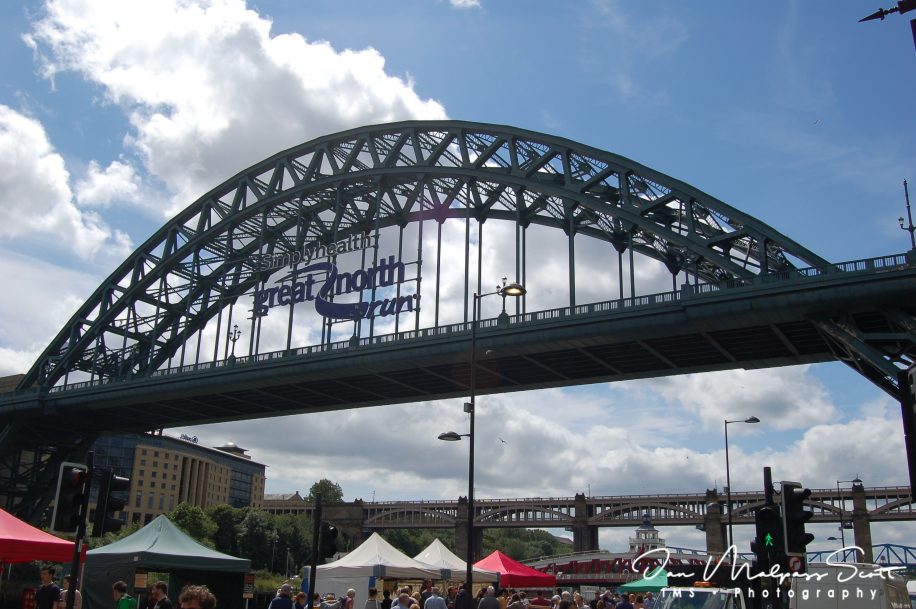The Tyne Bridge is a through arch bridge over the River Tyne in North East England, linking Newcastle upon Tyne and Gateshead. The Bridge was designed by the engineering firm Mott, Hay and Anderson, who later designed the Forth Road Bridge, and was built by Dorman Long and Co. of Middlesbrough. The bridge was officially opened on 10 October 1928 by King George V and has since become a defining symbol of Tyneside. It is ranked as the tenth tallest structure in the city.
History of construction
The earliest bridge across the Tyne, Pons Aelius, was built by the Romans near the location of the present Tyne Bridge around 122.
Work started in August 1925 with Dorman Long acting as the building contractors. Despite the dangers of the building work, only one worker, Nathaniel Collins, a father of four and a local scaffolder from South Shields, died in the building of this structure.
The Tyne Bridge was designed by Mott, Hay and Anderson, comparably to their Sydney Harbour Bridge version.These bridges derived their design from the Hell Gate Bridge in New York City. The bridge was completed on 25 February 1928, and officially opened on 10 October by King George V and Queen Mary, who were the first to use the roadway, travelling in their Ascot landau. The opening ceremony was attended by 20,000 schoolchildren who had been given the day off. Movietone news recorded the speech given by the King.
The Tyne Bridge’s towers were built of Cornish granite and were designed by local architect Robert Burns Dick as warehouses with five storeys. But, the inner floors of the warehouses in the bridge’s towers were not completed and, as a result, the storage areas were never used. Lifts for passengers and goods were built in the towers to provide access to the Quayside; they are no longer in use.
The bridge’s design uses a parabolic arch.
The bridge was originally painted green with special paint made by J. Dampney Co. of Gateshead. The same colours were used to paint the bridge in 2000. The bridge spans 531 feet (162 m) and the road deck is 84 feet (26 m) above the river level.
Technical Information
| Total length | 389 metres (1,276 ft) |
| Length of arch span | 161.8 metres (531 ft) |
| Rise of arch | 55 metres (180 ft) |
| Clearance | 26 metres (85 ft) |
| Height | 59 metres (194 ft) |
| Width | 17.08 metres (56.0 ft) |
| Structural Steel | 7,122 tonnes |
History of operations
Upon opening, the bridge carried the A1 road. Following the opening of the Tyne Tunnel in 1967, however, the A1 was diverted to the East and the road became the A6127. Following the construction of the Newcastle Western Bypass, the A1 moved again. The bridge was redesignated as the A167, which it remains today.
In 2012, the largest Olympic rings in the UK were erected on the bridge. The rings were manufactured by commercial signage specialists Signmaster ED Ltd of Kelso. The rings were over 25 metres wide and 12 metres tall and weighed in excess of 4000 kg. This was in preparation for Newcastle hosting the Olympic football tournament, and the Olympic torch relay, in which Bear Grylls zipwired from the top of the arch, to Gateshead quayside.
On 28 June 2012, a large lightning bolt struck the Tyne Bridge. It lit up the roads as the sky was very dark. The bolt, part of a super-cell thunderstorm, came with heavy rain – a month’s worth of rainfall in just 2 hours – causing flash flooding on Tyneside.
In 2015 Newcastle upon Tyne was a host city for the Rugby World Cup. Three matches were played at St James Park, the home of Newcastle United Football Club. In recognition, a large illuminated sign was erected on Tyne Bridge.
Kittiwake colony
The bridge and nearby structures are used as a nesting site by a colony of around 700 pairs of black-legged kittiwakes, the furthest inland in the world. The colony featured in the BBC’s Springwatch programme in 2010. Several groups, including the Natural History Society of Northumbria and local Wildlife Trusts, formed a “Tyne Kittiwake Partnership” to safeguard the colony. A proposal for a tower to be built as an alternative nesting site was made in 2011, and in November 2015 a neighbouring hotel submitted a planning application for measures to discourage the birds.


